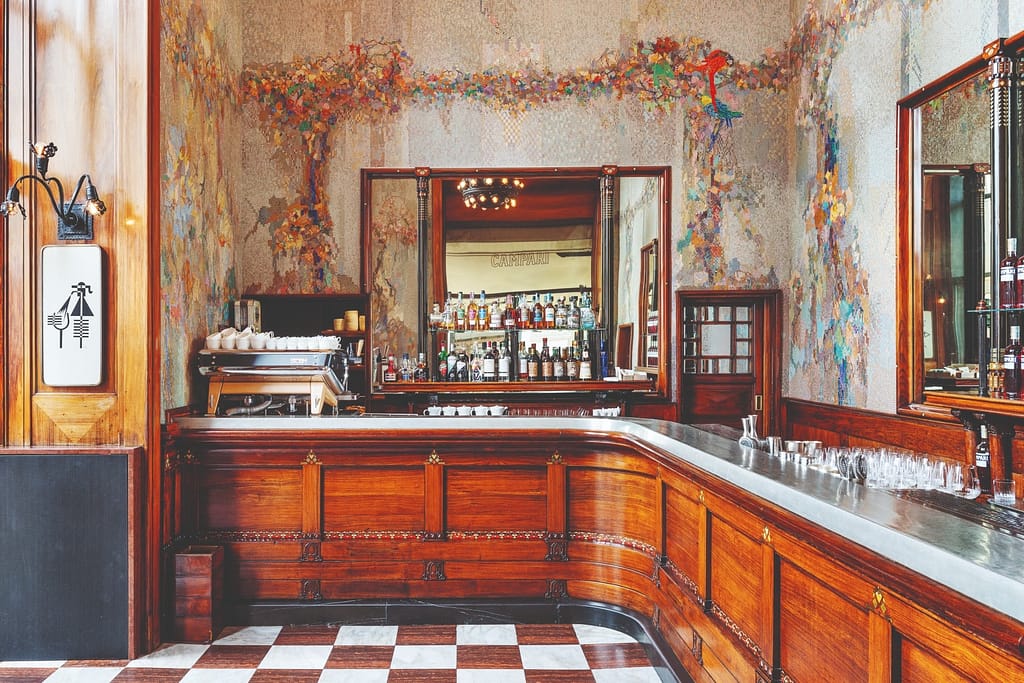[[{“value”:”
Camparino in Galleria enthuses the quintessence of Milanese aperitivo with its espresso house offering and Campari bar experience that invites guests to explore the same beauty Starbucks Founder Howard Schultz once did.
When visitors to Milan exit the Duomo station and look up, they are greeted with the sheer size and beauty of the city’s Cathedral. To the right, in Galleria Vittorio Emanuele II, lies Camparino in Galleria, which for coffee fans, offers almost the same religious experience.
Starbucks Founder Howard Schultz first visited Camparino in Galleria in the 1980s. It was this voyage to Milan, to attend an expo, and his first steps into Camparino in Galleria, that are said to have been the catalyst for his quest to develop an espresso-based coffee shop.
“I was exposed to something that completely lit a fuse inside me,” Schultz said in a YouTube interview with Graham Bensinger while seated in Camparino in Galleria, “the place where it all started”.
Schultz was overcome by a “lightning bolt of opportunity”, impressed by how highly trained and professional the baristas were, noting their sense of pride and integrity, and the ritual of people coming back to the same coffee bar every day. According to Tommaso Cecca, Global Head of Camparino Licensing and Mixology at Camparino in Galleria, Schultz would have been easily impressed by the beauty of the bar, and the energy of the Milanese people.
“[Schultz] said that the idea of Starbucks’ concept came out during his experience in Camparino in 1983, reading the newspaper and taking inspirations from routine of services the staff provided to the customers,” says Cecca.
Schultz once stood at the historic Bar di Passo, taking in the ambiance and beauty of the chestnut wood espresso bar. Forty years on, the bar counter has undergone a conservative restoration aimed at enhancing its historic and Art Nouveau heritage, including the illuminations, mosaic, and coffered ceiling. A full-height wall, decorated with original historical bottles and objects that tell the brand’s history, accompanies customers through the three rooms of the venue, located on the second floor, ground, and basement.
Davide Campari founded Camparino in Galleria in 1915. The bar was opened across the street from Caffè Campari, the establishment which Gaspare Campari, Davide’s father, founded in 1867.
Thanks to its strategic position in Piazza Duomo, the beating heart of Milan, Camparino in Galleria attracts international customers fascinated by the venue’s heritage and aperitif culture.
“Since its founding, Camparino in Galleria has been considered an icon and symbol of the aperitivo par excellence. It is strongly linked to the city of Milan and the artistic and cultural context of the 20th century,” Cecca says. “Besides being a meeting place and home of the Milanese aperitivo, it is also a symbol of excellence and pride for the city, which over time has been able to establish its prestige in the beverage and mixology scene in Italy and beyond.”
Camparino in Galleria is not only famous for aperitivo. It strongly believes in the quality of the food and coffee it serves.
“Coffee is considered one of the most important rituals,” Cecca says.
“We are famous for several things, and Italian quality is one of them. In Camparino we cannot give a different level of service and quality [other] than the best, with the best product and the highest standards at every moment of the day. This is our style.”
Camparino in Galleria serves about 30 kilograms of coffee per week via its Storm espresso machine from Barista Attitude. It serves Lavazza’s single origin Kafa, which Cecca says expresses acidity and freshness, and Alteco Bio as a blend, to guarantee a rounded coffee flavour.
“[Maintaining quality] is our main and most challenging duty every day as we’re open to the public 362 days per year. Consistency is one of the most important keys to success and I think Camparino is the brilliant representation of longevity and iconicity in the world,” Cecca says.
When the morning espresso round is complete, classic cocktails such as the Campari Seltz or Negroni served at Bar di Passo, are a reminder of the host city of Milan. Cecca says cocktails at Sala Spiritello Room are a true laboratory experimentation that combines bold and traditional ingredients. Camparino in Galleria is synonymous with excellence in the art of mixology, but also offers guests a culinary experience of the best pairing of food and cocktails. Coffee cocktails have even made their way on to the menu, with Cecca’s favourite, the Hazelnut Espresso Martini, using Frangelico liqueur instead of coffee liqueur.
“This is a cocktail that pairs the subtle sweetness of Italian hazelnuts with the bitterness of espresso coffee, creating a truly harmonious experience with complex, yet smooth and rich, balanced flavours,” Cecca says.
Cecca is proud to call Camparino in Galleria his daily office. He says it’s the bar’s guests however, that represent a diverse mix of nationalities and cultures, with very different backgrounds among them.
“Camparino’s doors are always open to welcome millions of guests, and this perfectly represents the soul of Milan as an inclusive and international city,” Cecca says.
This article was first published in the March/April 2024 edition of Global Coffee Report. Read more HERE.
The post What makes Milan’s Camparino in Galleria an iconic coffee venue appeared first on Global Coffee Report.
“}]]


